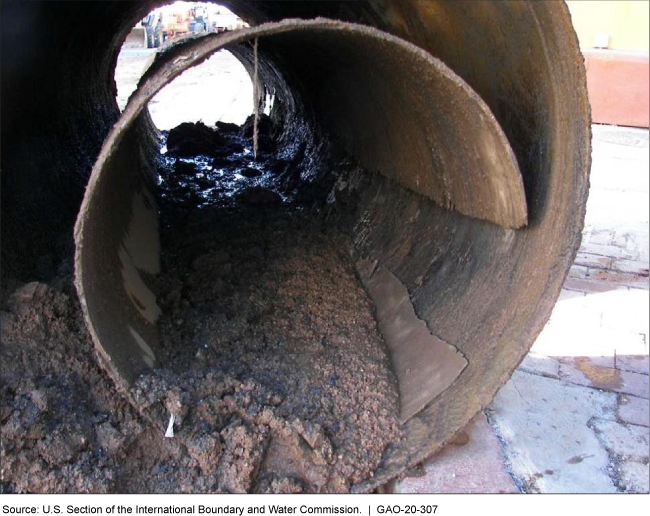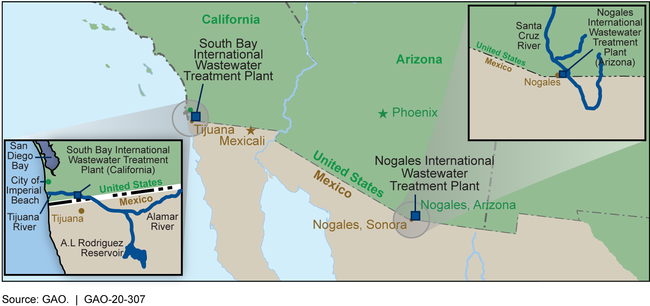International Boundary and Water Commission: Opportunities Exist to Address Water Quality Problems
Fast Facts
The U.S. Section of the International Boundary and Water Commission manages two wastewater treatment plants along the U.S.-Mexico border that treat raw sewage, mostly from Mexico. But population growth and aging plant infrastructure allow stormwater to bring bacteria, trash, and sediment from Mexico into the U.S.—affecting public health and the environment in Arizona and California.
The Commission has not taken comprehensive steps to resolve the problem, so we recommended that Congress consider directing the Commission to identify alternatives—including cost estimates and funding sources—to help resolve continuing water quality problems.
Corrosion of the International Outfall Interceptor (IOI) Pipe in Arizona

Corroded pipe
Highlights
What GAO Found
A 1944 treaty designated the International Boundary and Water Commission (IBWC) and authorized it to resolve water and boundary issues along the U.S.-Mexico border, including providing wastewater treatment. IBWC's two sections—the U.S. Section (USIBWC) and the Mexican Section, negotiated agreements to construct, manage, and operate two wastewater plants in Nogales, Arizona, and San Ysidro (South Bay), California, to resolve ongoing water quality problems stemming from sewage flowing downhill from Mexico into the United States (see figure). Several of these agreements describe each country's roles, such as sharing costs for the operation and maintenance of each plant.
International Wastewater Plants in Arizona and California

Several factors can affect the plants' operations, including deteriorating infrastructure in Mexico and the United States that results in raw sewage spills around the plants. USIBWC has taken steps to resolve some of these factors. For example, USIBWC proposed a binational rapid response team to address broken pipes and failing pumps that can send sewage from Mexico into the United States; however, the team has not been formalized to ensure its long-term operation. By taking steps to formalize the team, USIBWC would have assurance it can more effectively address recurring infrastructure failures contributing to sewage spills.
USIBWC and others have taken some actions to address stormwater problems, such as studying stormwater flows in the Tijuana River Valley watershed and building some retention basins. However, USIBWC has not taken action, in coordination with federal, state, and local partners, to identify alternatives, cost estimates, funding sources, and time frames for implementing solutions in either watershed. USIBWC officials said without direction from Congress, it does not have specific authorization for stormwater management in the watersheds because the 1944 treaty and accompanying legislation did not authorize it to carry out such projects. The long-standing stormwater quality problems and their associated environmental and health effects suggest congressional direction is needed to authorize USIBWC to take action. Such action would include identifying alternatives, cost estimates, funding sources, and time frames.
Why GAO Did This Study
Ongoing sewage spills and stormwater runoff carrying trash, sediment, and other pollutants in the Santa Cruz River Basin and Tijuana River Valley watersheds along the U.S.-Mexico border have affected public health, the environment, and local economies. Under the 1944 treaty, the United States and Mexico agreed to work together through IBWC to address these water quality problems. As part of this effort, USIBWC manages two wastewater treatment plants in Arizona and California. In 2018, the plants treated more than 14 billion gallons of sewage from Mexico.
This report (1) describes the authorities and roles for developing and managing the plants and sharing their costs; (2) examines factors affecting the operation of each plant and steps taken to address them; and (3) examines the extent to which USIBWC has taken actions to address water quality problems in the watersheds. GAO reviewed U.S-Mexico treaties, IBWC minutes and permits, and planning and budget data for USIBWC. GAO also interviewed officials from IBWC and other federal agencies, local and state governments, and non-governmental groups.
Recommendations
GAO believes that Congress should consider providing direction and specific authorization to USIBWC to take action to resolve stormwater quality problems in the Santa Cruz River Basin and Tijuana River Valley watersheds. GAO is also making two recommendations to USIBWC, including that it formalize the rapid response team. USIBWC concurred with that recommendation and partly concurred with the other.
Matter for Congressional Consideration
| Matter | Status | Comments |
|---|---|---|
| Congress should consider providing direction and specific authorization for USIBWC to take action to resolve the long-standing water quality problems associated with transboundary stormwater flows in the Santa Cruz River Basin watershed, including identifying alternatives, cost estimates, funding sources, and time frames, in coordination with federal, state, and local partners. (Matter for Consideration 1) | As of February 3, 2025, Congress has provided the USIBWC with authority to resolve the long-standing problems associated with transboundary stormwater flows in the Santa Cruz River Basin watershed. The FY2024 National Defense Authorization Act for Fiscal Year 2024 (FY2024 NDAA), directed USIBWC to assume full ownership of the International Outfall Intercept (IOI) under certain conditions (Pub. L. No. 118-31, § 5602, 137 Stat. 136, 956 (2023)). The IOI is the pipeline that brings Mexican wastewater into the U.S. to be treated and was in such disrepair that it leaked and was at risk of rupturing. The FY2024 NDAA also authorized $12.5 million in appropriations to operate and maintain the IOI. According to USIBWC officials, if appropriated, the funding will help maintain the IOI, thereby reducing water quality problems associated with transboundary stormwater flows in the Santa Cruz River Basin watershed. The FY2024 NDAA further directed USIBWC to initiate negotiations with Mexico to address joint operations and maintenance responsibilities for the IOI, wastewater capacity usage of the IOI, and payments for excess wastewater flows from Mexico through the IOI. The GAO will continue to follow congressional action for the appropriations of funding for the project and USIBWC negotiations with Mexico. | |
| Congress should consider providing direction and specific authorization for USIBWC to take action to resolve the long-standing water quality problems associated with transboundary stormwater flows in the Tijuana River Valley watershed, including identifying alternatives to include cost estimates, funding sources, and time frames, in coordination with federal, state, and local partners. (Matter for Consideration 2) | Enacted in 2020, the United States-Mexico-Canada Agreement (USMCA) Implementation Act provided $300 million in supplemental appropriations for EPA's "State and Tribal Assistance Grants" for architectural, engineering, planning, design, construction and related activities in connection with the construction of high priority wastewater facilities in the area of the United States-Mexico Border (Pub. L. No. 116-113, tit. IX, 134 Stat. 11, 100 (2020)). The USMCA Implementation Act required EPA to work in coordination with eligible public entities including USIBWC to address transboundary water pollution in the Tijuana River watershed. In September 2024, EPA formally transferred USMCA Implementation Act appropriations to the USIBWC for the South Bay International Wastewater Treatment Plant Rehabilitation and Expansion Project. According to USIBWC officials, through expanding the South Bay International Wastewater Treatment Plant and other actions being planned, the agency can resolve the long-standing water quality problems associated with transboundary stormwater flows in the Tijuana River Valley watershed with existing legal authority. GAO considers the intent of the matter to be met. |
Recommendations for Executive Action
| Agency Affected | Recommendation | Status |
|---|---|---|
| International Boundary and Water Commission, United States and Mexico | The U.S. Commissioner of the IBWC should work with the Mexican Commissioner to formalize a binational rapid response team to address sewage infrastructure failures along the U.S.-Mexico border, including the Nogales and South Bay wastewater treatment plants. (Recommendation 1) |
In January 2025, USIBWC officials said that the agency shifted its approach from a memorandum of agreement on rapid response to one of providing grants for Mexican officials to purchase necessary equipment. The equipment would be available to address issues in Mexico that cannot be adequately handled because the country lacks appropriate equipment. USIBWC has drafted language to be included in appropriations legislation for FY 2025-2026. GAO will continue to follow the appropriations legislation to determine if it is included.
|
| International Boundary and Water Commission, United States and Mexico | The U.S. Commissioner of the IBWC should direct USIBWC staff to conduct long-term capital planning for the Santa Cruz River Basin and Tijuana River Valley watersheds, following the principles in OMB Circular A-11. (Recommendation 2) |
In September 2024, USIBWC provided a Statement of Work, signed contract and modifications, and descriptions of actions to be implemented under its asset management plan, including for the two wastewater plants in the Santa Cruz River Basin and Tijuana River Valley watersheds. This contract will result in an asset management plan as GAO recommended and meets the intent of the recommendation.
|
